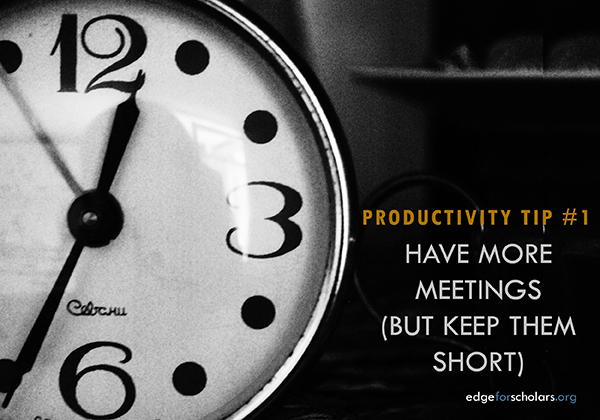Productivity Tip #1: Have More Meetings (But Keep Them Short)

Do your meetings take an hour to do what could’ve been accomplished in fifteen minutes? Do you look with dread at the colorful blocks on your Outlook calendar telling you your time is about to be wasted? Here are some ways to trim the fat and make meetings shorter and smarter.
Have More Meetings (But Keep Them Short)
by Matthew E. May
One of the most interesting things I observed over the eight years I spent as a creative advisor to Toyota was how a team of designers or engineers working on the same project might hold several short meetings over the course of the day—sometimes as many a five different times. The interesting aspects were three-fold:
- The meetings were not necessarily scheduled. They were held as needed, on a just-in-time basis. Further, they weren’t anchored by any scheduling software timeblocks. In other words, they weren’t slave to some multiple of 15 minutes. They might be 7 minutes, or 22 minutes. I saw one meeting last barely over a minute.
- Little discussion occurred. The meetings were held for a single purpose: to make a key decision.
- The meetings were in essence a formality. I learned that the Toyota project teams held a completely opposite view of the “meet and confer” philosophy held by most organizations. The “confer” part was held outside the meeting, conducted by individuals in one-on-one dialogs, so that by the time the meeting was held, all team input had been gathered and an informal consensus had been achieved.
Born in the factories of Toyota, “lean” was the term coined the 1996 book Lean Thinking and recently re-popularized by the 2011 book The Lean Startup. A lean practitioner looks at the world of work as being one of two things: value-adding, or non value-adding. The ultimate goal of becoming lean is to add value by eliminating everything that doesn’t.
While some of the success can be contributed to Toyota’s overall mindset of keeping things lean, the good news is that you don’t have to be Toyota to dramatically improve the results of your meetings in much the same fashion.
The critical starting point is to think of meetings as you would any other process: to be considered lean, a meeting must be characterized by minimal, and preferably absent, non value-adding work.






0 Comments